Check Best Thermostat Pricing in Amazon
** As an Amazon Associate, I earn from qualifying purchases.
The thermostat sensor is usually located inside the thermostat unit, mounted on a wall. It is often found in a central area of the home.
A thermostat sensor plays a crucial role in regulating home temperatures. Typically, it is positioned away from direct sunlight, drafts, and heat sources to ensure accurate readings. Central placement helps it gauge the average temperature of your living space effectively.
Proper sensor location can improve energy efficiency and comfort levels. Homeowners should regularly check and maintain the thermostat for optimal performance. Understanding its placement and function helps in troubleshooting temperature inconsistencies. For those considering an upgrade, modern smart thermostats offer advanced features for better climate control. Investing in a quality thermostat sensor enhances your home’s overall energy management.
- Introduction To Home Thermostat Sensors
- Ideal Locations For Thermostat Sensors
- Common Thermostat Sensor Locations
- Factors Affecting Thermostat Sensor Placement
- Problems With Improper Sensor Placement
- Installing And Moving A Thermostat Sensor
- Optimizing Thermostat Sensor Effectiveness
- Troubleshooting Common Sensor Issues
- Frequently Asked Questions
- Conclusion
Introduction To Home Thermostat Sensors
Understanding thermostat sensors is crucial for maintaining a comfortable home. These sensors play a key role in regulating your home’s temperature. They ensure you stay warm in winter and cool in summer.
The thermostat sensor is a small but essential device. It communicates with your home’s HVAC system. Knowing where this sensor is located can help you troubleshoot issues and optimize your comfort.
The Role Of Thermostat Sensors
Thermostat sensors detect the temperature in your home. They send this information to the thermostat. The thermostat then adjusts the heating or cooling based on the sensor’s data.
Accurate temperature detection is vital for energy efficiency. A well-placed sensor can help you save on energy bills. It ensures your HVAC system works only when needed.
Sensors can also help maintain even temperatures throughout your home. This prevents hot or cold spots. Consistent temperatures improve overall comfort.
Types Of Thermostat Sensors
Different types of thermostat sensors are available. Each type has its specific use and placement.
- Remote Sensors: These can be placed in different rooms. They help monitor temperature variations throughout the house.
- Built-In Sensors: These are integrated into the thermostat unit. They measure the temperature near the thermostat’s location.
- Wireless Sensors: These offer flexibility in placement. They can be placed anywhere within the range of the thermostat.
Choosing the right sensor depends on your home’s layout and your comfort needs. Understanding each type helps in making an informed decision.

Credit: powerhousedynamics.com
Ideal Locations For Thermostat Sensors
Choosing the ideal locations for thermostat sensors in a house is crucial. Correct placement ensures your home stays comfortable and energy-efficient. Misplaced sensors can lead to incorrect temperature readings and increased energy bills.
Central Placement Principles
The best place for a thermostat sensor is in the center of your home. This ensures it reads an average temperature of the entire house. Placing the sensor in a hallway is often ideal. Hallways are usually centrally located and away from direct sunlight.
Avoid putting the sensor near windows or doors. These areas can have drafts that affect the temperature reading. Keep the sensor at eye level, about 5 feet from the floor. This height helps the sensor get an accurate reading of the room’s temperature.
Avoiding Misleading Temperature Sources
Avoid placing the sensor near heat sources. Avoid locations close to radiators, stoves, or fireplaces. These areas can cause the sensor to read higher temperatures than the rest of the house. This leads to the heating system turning off prematurely.
Do not install the sensor in direct sunlight. Sunlight can cause the sensor to read a higher temperature. This will make your cooling system work harder, increasing energy costs. Also, avoid placing it near air vents, which can give false readings.
Consider these ideal locations for thermostat sensors to ensure accurate temperature readings and efficient energy use.
Common Thermostat Sensor Locations
Finding the thermostat sensor in a house can be tricky. Knowing where to look can save time and effort. This guide covers the most common thermostat sensor locations in a home.
Living Spaces
Thermostat sensors are often placed in living rooms. These areas are typically central in the house. A central location helps the sensor gauge the overall temperature better.
In living rooms, sensors can be found near seating areas. This ensures that the space where people gather is comfortable. Keeping the sensor away from direct sunlight or vents is crucial. Sunlight and vents can give inaccurate readings.
Hallways And Common Areas
Hallways are another common spot for thermostat sensors. Hallways connect different rooms and provide an average temperature reading. This makes them ideal for placing sensors.
In common areas like foyers, sensors can be mounted at eye level. This height helps in getting an accurate reading of the ambient temperature. Avoid placing sensors near doorways or windows. These spots may have drafts that can alter the sensor’s readings.
Here is a quick reference table for common thermostat sensor locations:
| Location | Reason |
|---|---|
| Living Rooms | Central location, accurate overall reading |
| Seating Areas | Ensures comfort where people gather |
| Hallways | Average temperature of connected rooms |
| Foyers | Ambient temperature at eye level |
Remember to avoid placing sensors near heat sources or drafts. This ensures that the temperature reading is accurate and reliable.

Credit: www.quora.com
Factors Affecting Thermostat Sensor Placement
Proper placement of a thermostat sensor in a house is vital for efficient temperature control. Several factors impact where the sensor should be located. Understanding these factors can help in achieving optimal comfort and energy savings.
Home Layout And Design
The layout and design of your home play a significant role in thermostat sensor placement. The sensor should be placed in a central location. This helps it to accurately gauge the overall temperature of the house. Avoid placing the sensor near windows or doors. These areas can have drafts, leading to inaccurate readings.
Avoid placing the sensor in direct sunlight. Sunlight can cause false temperature readings. Choose an interior wall that is easily accessible. This will ensure the sensor gets an average temperature reading for the home.
| Ideal Locations | Reasons |
|---|---|
| Central Interior Wall | Provides average temperature readings |
| Away from Windows and Doors | Prevents drafts from affecting sensor |
| Out of Direct Sunlight | Avoids false temperature readings |
External Climate Considerations
The external climate also affects where the thermostat sensor should be placed. In colder climates, place the sensor away from exterior walls. This helps to avoid cold drafts that can lead to inaccurate readings.
Check Best Thermostat Pricing in Amazon
** As an Amazon Associate, I earn from qualifying purchases.
In warmer climates, keep the sensor away from heat sources. This includes appliances like ovens or heaters. Heat sources can cause the sensor to read higher temperatures than actual. This can lead to inefficient cooling.
Consider the insulation of your home. Well-insulated homes have fewer temperature fluctuations. This makes sensor placement slightly less critical. Poorly insulated homes require more strategic placement to ensure accurate readings.
- Cold Climates: Place away from exterior walls
- Warm Climates: Avoid heat sources
- Insulation Quality: Affects temperature stability
Problems With Improper Sensor Placement
The placement of your thermostat sensor is critical for the efficient operation of your HVAC system. Improper sensor placement can lead to various problems, affecting both comfort and energy consumption. Below are some common issues caused by improper sensor placement.
Inaccurate Temperature Readings
Sensors placed near heat sources like ovens or direct sunlight can give false readings. This can cause your HVAC system to run longer than necessary, wasting energy. Cold spots can also mislead the sensor, making your home feel colder or warmer than it is.
| Heat Sources | Cold Spots |
|---|---|
| Ovens, Stoves, Heaters | Drafty Windows, Doors |
| Direct Sunlight | Uninsulated Walls |
Impacts On Hvac Efficiency
Improper sensor placement can reduce the efficiency of your HVAC system. This can lead to higher energy bills. When the sensor is in a poor location, the HVAC system may cycle on and off frequently. This wears out the equipment faster.
- Frequent Cycling: Shortens lifespan of HVAC equipment.
- High Energy Bills: Wastes energy and money.
- Inconsistent Comfort: Uneven temperatures throughout the house.
For optimal performance, place your thermostat sensor in a central location away from heat sources and cold spots. This ensures accurate readings and efficient operation.
Installing And Moving A Thermostat Sensor
Installing and moving a thermostat sensor can improve your home’s comfort. Proper placement ensures accurate temperature readings. This guide helps you with DIY installation tips and when to call a professional.
Diy Installation Tips
Follow these steps for a successful DIY installation:
- Choose a central location: Place the sensor in a room you use often.
- Avoid direct sunlight: Sunlight can cause false readings.
- Keep away from vents: Airflow from vents can affect temperature readings.
- Drill
- Screwdriver
- Level
- Measuring tape
- Turn off power to your HVAC system.
- Remove the old thermostat sensor if there is one.
- Mark the new sensor’s location on the wall.
- Drill holes for mounting screws.
- Attach the sensor to the wall.
- Connect the wires following the manufacturer’s guide.
- Turn the power back on and test the sensor.
When To Call A Professional
- Complex wiring: If the wiring seems confusing, call an expert.
- Multiple zones: Homes with multiple zones may need professional setup.
- New systems: Installing a new HVAC system often requires professional assistance.
| Benefit | Description |
|---|---|
| Expertise | Professionals ensure proper installation and function. |
| Safety | They handle electrical work safely. |
| Efficiency | Professionals complete the job quickly and correctly. |
Optimizing Thermostat Sensor Effectiveness
Optimizing your thermostat sensor can save energy and money. It can also make your home more comfortable. Here are some tips to ensure your thermostat sensor works its best.
Regular Maintenance
Regular maintenance is key to a well-functioning thermostat sensor. Dust and dirt can block the sensor, affecting its accuracy. Clean the sensor gently with a soft cloth. Make sure no debris is left behind.
Check the sensor’s placement. It should be away from direct sunlight, vents, and windows. These can cause false readings. Ensure the sensor is in a central location.
Inspect the thermostat wiring. Loose wires can cause malfunctions. Tighten any loose connections carefully. If you see any damage, consider replacing the wires.
Smart Thermostat Upgrades
Upgrading to a smart thermostat can enhance sensor effectiveness. Smart thermostats offer advanced features. They can learn your schedule and adjust settings automatically.
- Remote Control: Control your thermostat from your smartphone.
- Energy Reports: Get insights on your energy usage. Make informed decisions to save energy.
- Geofencing: The thermostat can detect when you are home or away. It adjusts settings accordingly.
Smart thermostats also support voice control. You can adjust settings using voice commands. This adds convenience and ease of use.
| Feature | Benefit |
|---|---|
| Remote Control | Adjust settings from anywhere |
| Energy Reports | Monitor and reduce energy use |
| Geofencing | Automatic adjustments based on location |
Consider upgrading to a smart thermostat for better efficiency. This investment can lead to significant savings and improved comfort.
Troubleshooting Common Sensor Issues
Thermostat sensors play a crucial role in maintaining a comfortable home environment. They detect the temperature and relay this information to your thermostat. But sometimes, these sensors can encounter issues. Here’s how you can troubleshoot some of the most common sensor problems.
Calibration Challenges
Calibration ensures your thermostat sensor reads the correct temperature. If the sensor is not calibrated correctly, your home may feel too hot or too cold. Regular calibration checks can help maintain accuracy.
- First, compare the thermostat reading with an accurate thermometer.
- Next, follow the thermostat’s manual to adjust the sensor.
- Finally, check the readings again to ensure they match.
If the sensor still shows incorrect readings, it may need replacement. Frequent recalibration could indicate a failing sensor.
Dealing With Sensor Failure
A failed sensor can disrupt your home’s comfort levels. Identifying a failed sensor early can save you time and discomfort. Here are some signs of sensor failure:
| Symptom | Possible Cause |
|---|---|
| Inconsistent temperatures | Faulty sensor readings |
| Thermostat not responding | Sensor disconnection |
| Frequent HVAC cycling | Sensor sending incorrect signals |
To address these issues, follow these steps:
- Turn off the thermostat and HVAC system.
- Inspect the sensor for any visible damage or loose connections.
- If damaged, replace the sensor with a compatible model.
- Reconnect and secure any loose wires.
- Turn the system back on and monitor its performance.
Regular maintenance can prevent many sensor-related issues. Routine checks can ensure your thermostat sensor works correctly, keeping your home comfortable.

Credit: www.researchgate.net
Frequently Asked Questions
Where Is The Temperature Sensor Located In My House?
The temperature sensor is often located in a central area, like a hallway. Check near the thermostat.
Where Is The Sensor Located In A Thermostat?
The sensor in a thermostat is usually located inside the device itself. It measures the room’s temperature.
Is There A Temperature Sensor In A Home Thermostat?
Yes, a home thermostat includes a temperature sensor. It measures indoor temperature to maintain your desired comfort level.
How To Fix A Thermostat Sensor In A House?
To fix a thermostat sensor, first turn off the power. Remove the thermostat cover, clean the sensor, and check for damage. Reassemble and test.
Conclusion
Finding your thermostat sensor is key to efficient home temperature control. Typically, sensors are near the thermostat. Check hallways, living rooms, or bedrooms. Proper placement ensures accurate readings and energy savings. Regular maintenance can prolong your HVAC system’s life. Understanding your thermostat setup can enhance comfort and efficiency in your home.
Check Best Thermostat Pricing in Amazon
** As an Amazon Associate, I earn from qualifying purchases.

